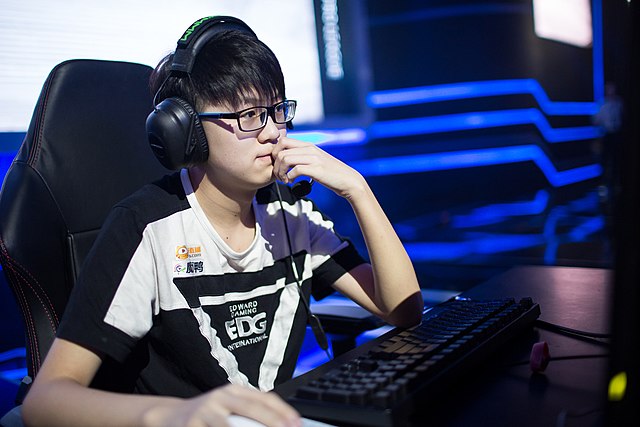
Thammasat University students interested in comparative religion, video game design, cultural sociology, history, consumer studies, social theory, and related subjects may find a new book useful.
The Pop Theology of Videogames: Producing and Playing with Religion is an Open Access book available for free download at this link.
The Thammasat University Library collection includes several books about different aspects of videogames.
Its author is Assistant Professor Lars de Wildt, who teaches media and cultural industries at the Centre for Media and Journalism Studies, University of Groningen, the Netherlands.
Some researchers who recognize videogames as significant sociopolitical forces have noted religious elements in them. Because of their influence, especially on young people, it is worth considering the ethical and moral lessons they may contain.
Videogames increasingly turn to religion as basic elements of their design and play. Some games involve moral decision, rely on invented religions, and allow users to create and experience virtual religious spaces.
The publisher’s description of the book follows:
Young people in the West are more likely to encounter religion in videogames than in places of worship like churches, mosques or temples. Lars de Wildt interviews developers and players of games such as Assassin’s Creed to find out how and why the Pop Theology of Videogames is so appealing to modern audiences. Based on extensive fieldwork, this book argues that developers of videogames and their players engage in a ‘Pop Theology’ through which laymen reconsider traditional questions of religion by playing with them. Games allow us to play with religious questions and identities in the same way that children play at being a soldier, or choose to ‘play house.’ This requires a radical rethinking of religious questions as no longer just questions of belief or disbelief; but as truths to be tried on, compared, and discarded at will.
This is the abstract of Assistant Professor de Wildt’s research:
Abstract Religion is surprisingly common in videogames. That is odd: religion was supposed to disappear under modernity, but survives in media despite decreased church attendance. It is now far more likely for young people to encounter religion in videogames than in church. Why is that so? And how should that change our understanding of religion? In this introduction, I summarize the related literatures on secularization, religion, games and play. Particularly religion and play have been theoretically intertwined, from the works of Durkheim and Huizinga to those of contemporary experts on games and religion – some of whom have been overly enthusiastic about finding religion. I finish by outlining how this book will theorize the pervasive and persistent presence of religion in contemporary videogames, asking why game makers use religion in their games, and how players make sense of this.

The author states that
religion has appeared so centrally in videogames since their inception, that religion has become such an unsurprising presence, that it is barely registered by the very people who make and play those games. Second, that developers use religion in their work in ways that are so far divorced from religious practice and belief that it no longer strikes them as religious at all – but as just a convention of the genre, perhaps, or as such a minute detail (a texture, a building, a piece of music worked on for months) that it loses its religious context until an outsider like me points it out. Third, that videogames tend to depict religion in such a way that it neither offends, nor surprises, nor is necessarily even noticed by most, no matter how strong or absent their audiences’ personal religious beliefs are. Speaking of such audiences: as players ourselves, my friends and I grew up playing as Priests (Thomas), Druids (Johan), Shamans (Jan) and holy Paladins (Lars). We gained our quests from gods, to slay demons or find sacred artefacts. None of this was odd to us, despite growing up in the Netherlands, one of the most secular countries in the world. We were playing with religion in the same way that children might play soldier, doctor, shop, or house. In such cases, we pretend to be in imaginary situations precisely because they are so different from our daily lives. For many of the people I have studied for this book, as well as the people I have presented my findings to, playing with religion is about as far removed from our daily lives as being a medical doctor. The research for this book has been conducted and presented in Australia, Belgium, Canada, the Czech Republic, Denmark, Finland, the Netherlands, and other countries. These are some of the most secular countries in the world, with many individuals (making up a large percentage of the population) reporting that they are “not a religious person” or even “convinced atheists”. Notably, the percentage among academics and other highly educated people is even higher. As a consequence, the inverse of the question above haunts me academically as well, on research visits, at conferences, and receptions – just as it haunts this text: What do videogames have to do with religion, anyway? Surely, not only developers, players and academics, but also the reader of this book, should be wondering the same thing. Religion is treated in many circles I frequent, both professionally and privately, as obscure, old-fashioned or even strangely taboo. Yet, or perhaps because of those reasons, religions of all kinds are staples in videogames. They have served as an inspiration and a setting for games across decades, platforms and genres – and religion sells. One of 2022’s most anticipated releases was Elden Ring, a game filled with various religions and mythologies. The previous year saw another release of Halo, in which – if the name was not enough – an alien “Covenant” faction seek religious artefacts and transcendence. The best-selling Game of the Year in 2020 was Hades, about the Greek god Zagreus escaping the underworld. In 2019 many Game of the Year lists were dominated by Sekiro, a game filled to the brim with Buddhist references and Shinto rituals. In 2018 it was God of War, whose ancient Greek protagonist moved to a Norse mythological setting, the sequel of which was one of 2022’s biggest releases. In 2017? The Legend of Zelda. A game series made by Nintendo since 1986, whose churches, temples and Jesus-like hero are heavily based on its Japanese designers’ fascination with the magic and symbology of an exotic and mysterious faraway religion: Catholicism. Such examples abound. Indeed it is more likely for “young” people in the 21st century – the average age of players in the United States is 34 – to encounter religion in videogames than they would in church or anywhere else.

(All images courtesy of Wikimedia Commons)
